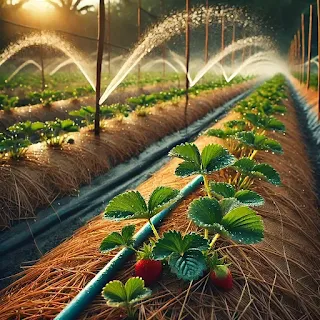How to Grow Blueberries in Hot Climates
Author: Shweta Goyal
Introduction
Blueberries are known for their delicious taste and nutritional benefits, but growing them in hot climates can be tricky. With the right strategies, you can successfully cultivate blueberries in warm regions. This guide provides essential tips on how to grow blueberries in hot climates, ensuring you enjoy a bountiful harvest.
Climate and Soil Requirements
Choosing the Right Location
Select a location that receives morning sun and afternoon shade. This helps protect the plants from the intense afternoon heat. Blueberries prefer well-drained, acidic soil with a pH of 4.5-5.5.
Choosing the Right Location for Blueberries - Author: Shweta Goyal
Soil Preparation
Prepare the soil by incorporating organic matter such as peat moss or pine bark. This improves soil structure, drainage, and acidity, creating an ideal environment for blueberry plants.
Soil Preparation for Blueberries - Author: Shweta Goyal
Watering and Mulching
Consistent Watering
In hot climates, maintaining consistent soil moisture is crucial. Water the plants regularly, ensuring the soil remains moist but not waterlogged. Drip irrigation systems can be particularly effective in providing consistent moisture.
Mulching
Apply a thick layer of mulch around the plants to retain soil moisture and regulate soil temperature. Organic mulches like pine needles or wood chips are excellent choices.
Watering and Mulching Blueberries - Author: Shweta Goyal
Providing Shade
Using Shade Cloth
Protect blueberry plants from the scorching sun by using shade cloth. A shade cloth with 30-50% shading can significantly reduce heat stress on the plants.
Natural Shading
Plant taller companion plants, such as sunflowers or corn, to provide natural shading for your blueberries. This method creates a microclimate that is cooler and more conducive to blueberry growth.
Using Shade Cloth for Blueberries - Author: Shweta Goyal
Selecting Heat-Tolerant Varieties
Recommended Varieties
Choose blueberry varieties known for their heat tolerance. Some excellent options include Sharpblue, Misty, and Jewel. These varieties can withstand higher temperatures and still produce high yields.
Heat-Tolerant Blueberry Varieties - Author: Shweta Goyal
Pest and Disease Management
Common Pests
Monitor for common pests such as aphids, spider mites, and birds. Use organic pest control methods like neem oil, insecticidal soap, or bird netting to manage pest populations.
Disease Prevention
Ensure good air circulation around the plants and avoid overhead watering to prevent fungal diseases. Rotate crops and remove any diseased plants promptly to reduce the risk of disease spread.
Harvesting and Post-Harvest Care
Harvesting Tips
Harvest blueberries when they are fully blue and slightly soft. Pick the berries gently to avoid bruising and place them in a shallow container to prevent crushing.
Post-Harvest Storage
Store harvested blueberries in the refrigerator to prolong their freshness. For long-term storage, consider freezing the berries or making preserves.
Conclusion
Growing blueberries in hot climates requires careful planning and management, but it is entirely possible with the right techniques. By selecting heat-tolerant varieties, providing shade, maintaining consistent moisture, and managing pests, you can enjoy a successful blueberry harvest even in warm regions. Happy gardening!

















.jpeg)







